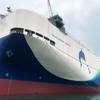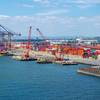A one point gain on the Baltic Dry Index to 1,320 disguised some significant differences in freight market movements since the last trading day by the Baltic Exchange on December 24, brokers said.
Capesizes appeared to have eased world-wide and there were reports of early vessels still available for employment, but Panamax demand strengthened significantly, especially in the Far East.
Brokers said that there was an over-supply of handy sizes on the Continent but that conditions for these vessels were steadier from Brazil and Argentina.
The Baltic Panamax Index jumped 36 points to 1,247, while the Baltic Capesize Index fell 31 points to 1,782 and the Baltic Handy Index slipped two points to 940.
Grain charterers opened the year with brisk inquiry, brokers said.
Toepfer quoted a fresh order of 55,000 tons heavy grain U.S. Gulf/Egypt for January 15/25, and it was reported that Dreyfus, Cargill, Zennoh and MISR also quoted similar business.
Panamax owners were said to be asking $9,500/$9,750 for Atlantic round voyages.
Timecharter rates for grain U.S. Gulf/Far East appeared steady on the evidence of Keoyang's fixture of the 1995-built Eleranta 73,500 dwt delivery U.S. Gulf mid-January trip Japan at $9,750 daily plus $200,000 ballast bonus. It was understood that other comparable fixtures had been concluded on private terms.
In the Far East, the imminent announcement of the Pakistan grain tender contributed to firmer market conditions in that area.
Little was heard of handy size grain activity in the Atlantic but reports circulated the market that Toepfer had booked Stella Tingas of 1.2 million cubic feet capacity before Christmas for Tampa/Ireland grain at $13.75/14.00 basis 53 feet.
Subscribe for
Maritime Reporter E-News
Maritime Reporter E-News is the maritime industry's largest circulation and most authoritative ENews Service, delivered to your Email five times per week









